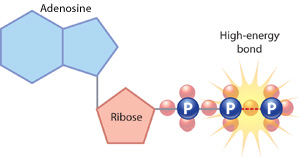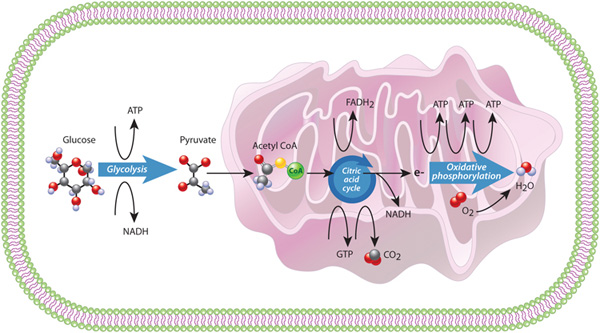What Type Of Molecule Provides The Most Efficient Form Of Energy Storage In Animals

Effigy 5: An ATP molecule
ATP consists of an adenosine base (blueish), a ribose sugar (pink) and a phosphate concatenation. The high-energy phosphate bond in this phosphate chain is the central to ATP'southward energy storage potential.
The particular energy pathway that a cell employs depends in large role on whether that prison cell is a eukaryote or a prokaryote. Eukaryotic cells use three major processes to transform the energy held in the chemic bonds of food molecules into more readily usable forms — often energy-rich carrier molecules. Adenosine 5'-triphosphate, or ATP, is the nigh arable energy carrier molecule in cells. This molecule is fabricated of a nitrogen base (adenine), a ribose carbohydrate, and three phosphate groups. The word adenosine refers to the adenine plus the ribose sugar. The bond between the 2d and tertiary phosphates is a loftier-energy bond (Figure v).
The showtime process in the eukaryotic free energy pathway is glycolysis, which literally means "sugar splitting." During glycolysis, single molecules of glucose are split and ultimately converted into two molecules of a substance called pyruvate; because each glucose contains 6 carbon atoms, each resulting pyruvate contains just three carbons. Glycolysis is actually a series of ten chemical reactions that requires the input of ii ATP molecules. This input is used to generate iv new ATP molecules, which means that glycolysis results in a cyberspace gain of two ATPs. Two NADH molecules are also produced; these molecules serve as electron carriers for other biochemical reactions in the cell.
Glycolysis is an ancient, major ATP-producing pathway that occurs in almost all cells, eukaryotes and prokaryotes alike. This process, which is also known as fermentation, takes identify in the cytoplasm and does not require oxygen. However, the fate of the pyruvate produced during glycolysis depends upon whether oxygen is present. In the absence of oxygen, the pyruvate cannot be completely oxidized to carbon dioxide, and so diverse intermediate products result. For example, when oxygen levels are low, skeletal muscle cells rely on glycolysis to encounter their intense energy requirements. This reliance on glycolysis results in the buildup of an intermediate known every bit lactic acrid, which tin cause a person's muscles to feel equally if they are "on fire." Similarly, yeast, which is a single-celled eukaryote, produces alcohol (instead of carbon dioxide) in oxygen-scarce settings.
In contrast, when oxygen is bachelor, the pyruvates produced by glycolysis become the input for the next portion of the eukaryotic free energy pathway. During this stage, each pyruvate molecule in the cytoplasm enters the mitochondrion, where it is converted into acetyl CoA, a 2-carbon energy carrier, and its third carbon combines with oxygen and is released equally carbon dioxide. At the aforementioned time, an NADH carrier is also generated. Acetyl CoA so enters a pathway chosen the citric acrid cycle, which is the second major energy process used by cells. The eight-footstep citric acid bike generates three more NADH molecules and two other carrier molecules: FADHtwo and GTP (Effigy 6, middle).

Figure 6: Metabolism in a eukaryotic jail cell: Glycolysis, the citric acrid cycle, and oxidative phosphorylation
Glycolysis takes place in the cytoplasm. Within the mitochondrion, the citric acid cycle occurs in the mitochondrial matrix, and oxidative metabolism occurs at the internal folded mitochondrial membranes (cristae).
The third major process in the eukaryotic free energy pathway involves an electron transport chain, catalyzed by several protein complexes located in the mitochondrional inner membrane. This process, chosen oxidative phosphorylation, transfers electrons from NADH and FADH2 through the membrane poly peptide complexes, and ultimately to oxygen, where they combine to course h2o. Every bit electrons travel through the protein complexes in the chain, a slope of hydrogen ions, or protons, forms across the mitochondrial membrane. Cells harness the energy of this proton slope to create iii boosted ATP molecules for every electron that travels along the chain. Overall, the combination of the citric acid cycle and oxidative phosphorylation yields much more energy than fermentation - fifteen times as much free energy per glucose molecule! Together, these processes that occur inside the mitochondion, the citric acid cycle and oxidative phosphorylation, are referred to as respiration, a term used for processes that couple the uptake of oxygen and the production of carbon dioxide (Effigy six).
The electron transport concatenation in the mitochondrial membrane is not the only one that generates free energy in living cells. In establish and other photosynthetic cells, chloroplasts also have an electron send concatenation that harvests solar free energy. Even though they practice not contain mithcondria or chloroplatss, prokaryotes take other kinds of energy-yielding electron ship chains within their plasma membranes that also generate energy.
Source: https://www.nature.com/scitable/topicpage/cell-energy-and-cell-functions-14024533/
Posted by: phillipsnotat1938.blogspot.com

0 Response to "What Type Of Molecule Provides The Most Efficient Form Of Energy Storage In Animals"
Post a Comment